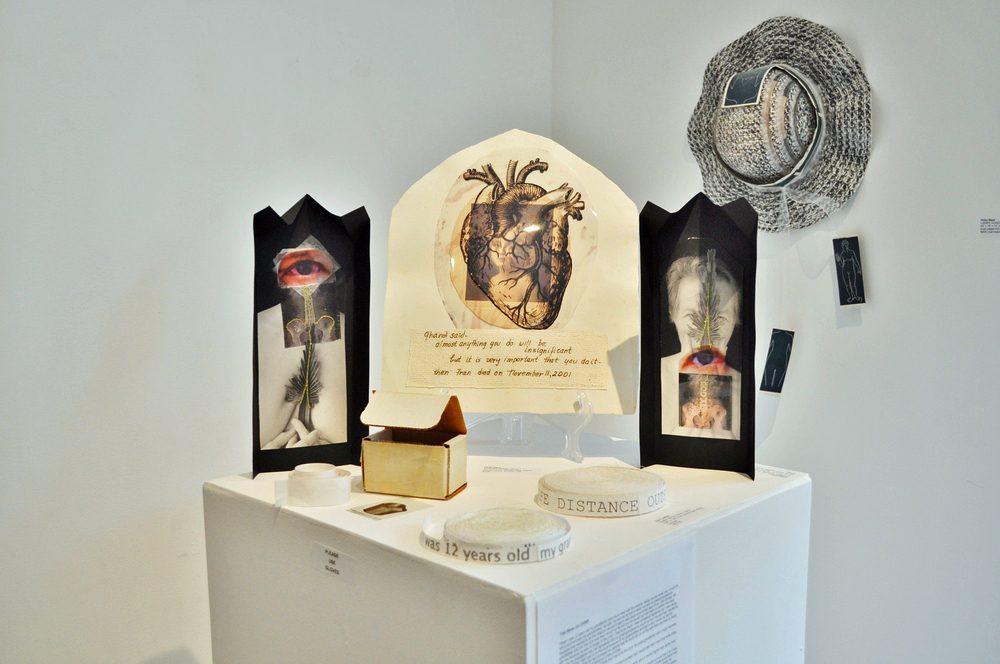Turning the Page: “BOOKS/CATALYSTS” at the Foundation Gallery
Benjamin Morris looks at a recent exhibition at the Foundation Gallery that asks viewers to rethink what a book can be.

Installation view of “BOOKS/CATALYSTS” at the Foundation Gallery, New Orleans. Courtesy the artists and the Foundation Gallery, New Orleans.
What is a book? Since the dawn of recorded time, the means of that recording has undergone a process of constant evolution. Tablet, scroll, papyrus, manuscript, codex: Though many of these technologies belong largely to our past, they have each played pivotal roles in yielding the object that we call the book today. So, too, have associated technologies, such as ink, styluses, and book storage, as Lydia Pyne has recently documented in Bookshelf, experienced continual innovations and developments. Indeed, even the modern concept of a book—say, a trade paperback or hardcover—refuses an easy stability: Following the invention of the printing press and standardized type, books have scarcely homogenized in form. Rather, their diversity over the past 500 years has only grown.
To celebrate this variety, “BOOKS/CATALYSTS,” a recent exhibition curated by artist Jon Coffelt at the Foundation Gallery, sets out to explore the art of the book. Looking at the history of book arts since the 1960s, the show seeks both to survey the book as art object itself and to present new artworks wherein the book is the medium or raw material for the work. Featuring a selection of unique, privately-owned art books (from a collection shared by Coffelt and another artist) rarely displayed in public, the exhibition stretches the definition of the book in ways that both foreground bookmakers’ talents and stimulate the working artist’s mind.
The exhibition’s art books from the 1960s to the present include examples that are at times charming, curious, and conceptually challenging. The 1994 poetry book Clearwater by Jim Koss, for instance, is scarcely larger than a person’s thumb and, opening in a horizontal fold, reveals precise, delicate poems that are pleasing both individually and collectively. Here the vessel is perfectly suited to its contents. More ambitiously, Susan E. King’s Treading the Maze from 1993 features an innovative double spine that creates a series of alternating graphic and narrative overlays. Charting the author’s experience with breast cancer, the book simultaneously tells King’s story in verbal and visual format, suggesting one path for turning the pages but refusing to dictate how to do so.
Unsurprisingly, novel bindings, such as hand-stitched and accordion-folded ones, dominate the show. Paired with loose-leaf assemblages such as Dieter Roth’s mesmerizing Book AC, 1964, a hypnotic experience of optical illusions and pattern formation through cut paper, these works offer a visual and tactile feast at the very least. Elsewhere, works such as Miranda Maher’s 100 Coordinates of Violence confound typical literary expectations for a book, reprinting an identical image with a different series of numbers on each page, coordinates of latitude and longitude that signal documented acts of violence across the globe: Here, the work suggests, the true book is out there in the world, for the reader to go and discover. Books with rare, irreplaceable ephemera, such as Russian Samizdat Art, edited by Charles Doria, similarly serve as a potent reminder of the threats books have always posed to institutional power and enforced ignorance.
To his credit, Coffelt has included a great number of books, so many that a single visit is not enough to take them all in. Yet this kitchen-sink approach does have downsides: The inclusion of some books which are little more than collections of postcards stretches the definition to the point of snapping, and, books that are merely catalogues of visual artists’ works are, for the most part, distractions, risking little and accomplishing less. Where the show does succeed, however, is in including artists who use the book as a conceptual inspiration or as a physical material, such as the works on display by Pinky Bass, Dana Jo Cooley, and Coffelt himself.
Among these, Bass’ mixed-media collages stand out as particularly gripping. In her works Aunt Nell’s Diary #1-3, 2001, Bass takes the diary of a deceased relative who was blinded at an early age by an infection and reproduces it both in pencil and in Braille in a moving montage. Refusing to allow modern viewers to take their sight for granted, these collages simultaneously reassert the accomplishment of developing a written language for the blind and reclaim the voice of a woman who likely would have otherwise been lost to history. In Super String Theory, 1993, Coffelt reimagines the ancient scroll as book and artwork, provocatively modernized by its inclusion of type, and Cooley, in her series untitled #1-4, uses the book form as its own singular architecture, recalling the world-famous book sculptures that mysteriously appeared at libraries across Scotland beginning in 2011.
In the 1980s cult film Repo Man, there’s a scene in which Emilio Estevez and Harvey Keitel stop off for refreshment at a gas station. In the science-fictional future America, however, their only choices are plain white cans labeled “drink.” Intended partly as a satire of the Soviet-planned economy, the horror of homogeneity is nonetheless real. Likewise, while “BOOKS/CATALYSTS” could have benefitted from a slightly stricter door policy for its works, overall the show offers a challenging, enervating journey through bookmaking’s recent history. Ultimately, with the range of works on offer, one is perhaps reminded most of the wearied sigh of the great sage Solomon, recorded approximately 2500 years ago: “Of the making of many books there is no end, and much study wearies the body” (Ecclesiastes 12:12).
Editor's Note
“BOOKS/CATALYSTS” was on view June 3 – 26, 2016, at the Foundation Gallery (1109 Royal Street) in New Orleans.



